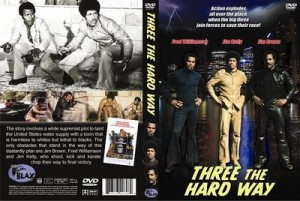 Blaxploitation films were a staple in grind house theaters, which subsequently died by the end of the ‘70s. The films were often set in the decaying neighborhoods of the ghetto, where one man or a group would try to correct the wrongs put upon them by a corrupt society. That genre spawned a series of films that dealt with race/hate relationships, which were the most bizarre and jaded films to be produced from this time. “Three the Hard Way” is the most mild film to come out of this genre, and it suffers from an illogical plot and some awkwardly staged fight scenes. Nevertheless, it provides an ample amount of chuckles and kitschy entertainment value.
Blaxploitation films were a staple in grind house theaters, which subsequently died by the end of the ‘70s. The films were often set in the decaying neighborhoods of the ghetto, where one man or a group would try to correct the wrongs put upon them by a corrupt society. That genre spawned a series of films that dealt with race/hate relationships, which were the most bizarre and jaded films to be produced from this time. “Three the Hard Way” is the most mild film to come out of this genre, and it suffers from an illogical plot and some awkwardly staged fight scenes. Nevertheless, it provides an ample amount of chuckles and kitschy entertainment value.
If you took a careful look at the race/hate genre of filmmaking, you might honestly be appalled with what you might stumble upon. “Mandingo” was a sickening look at slavery as seen from the perspective of plantation owners, while “Fight for Your Life” depicted a harrowing experience of a black family being held by hostage by a vile racist. Compared to the two films mentioned, “Three the Hard Way” deals with lighter circumstances, and that makes it feels more like a pulp novel.
The premise concerns a group of white supremacists that have discovered a way to poison the water supply. Here is the catch: The toxin is only harmful to black people. The plan is to poison the water in Detroit, New York and Los Angles at the same time. It is up to Jim Brown, Fred “The Hammer” Williamson and Jim Kelly to save the day with their unique brand of justice.
Oddly enough, this was produced by Warner Bros. to cash in on the success of blaxploitation. It also took the three biggest male stars of the genre and put them in one picture, which assured success of this picture on the Deuce.
Also, the villains are played by such awful actors that they never seem like a real threat, and that allows you to take the film less seriously than you would a picture like “Mandingo.â€
Brown’s post-football career kicked off with mainstream films such as “The Dirty Dozen” and “Ice Station Zebra,” but eventually succumbed to the appeal of being a leading man in blaxploitation. The great thing about Brown is that is he is always a pleasure to watch, and a very capable actor – he deserved to be in better movies than “Three The Hard Way.”
However, his onscreen chemistry with the Hammer makes the movie better than it should be.
Kelly, on the other hand, was immortalized in “Enter the Dragon,” which paved the way for him to be the star of many grade-Z martial-arts movies, including “Black Belt Jones” and “Hot Potato.” He has a wonderful screen presence, and expresses his knowledge of martial arts in every film.
In “Three the Hard Way,” Kelly plays Mister Keyes, and has one of the most unintentionally funny introductions in movie history. A group of mostly white cops decide for some obscure reason to plant drugs in his car and arrest him, just for the hell of it. He takes down all of the officers, and even stops to chat with some friends on the corner afterwards. But there is a tongue-in-cheek feeling here, and that it was purposely intended for a laugh by the director.
More bizarre scenes keep coming, like a motorcycle gang of sadomasochist women who are hired to torture one of the kidnapped racists. You will have no clue what they are doing, but for some reason, they do it topless. While this is an imaginative aspect to the film, it needed to be elaborated on.
Gordon Parks Jr. (“Super Flyâ€) was a talented director, whose career was cut short in 1979. His exploitation films were always a cut above the rest stylistically, and if his career lasted longer, he could have easily went into mainstream cinema.
“Three the Hard Way” is a film that would have never been produced in today’s politically-correct era of filmmaking, but it’s an interesting and unintentionally humorous look at just how silly grind house fare can get.

Leave a Reply